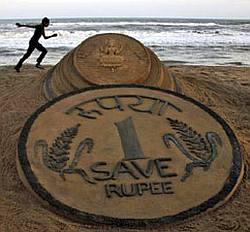
Will the rupee keep falling in value against the US dollar? What will be its impact?
The Indian rupee hit a two-year low of 66.82 against the US dollar recently on September 7. It has been falling in value against the US dollar everAugust 11.
Incidentally, when India received its independence in 1947, the value of the rupee was on a par with the American dollar. External borrowings to finance development and the wars in 1962 (China) and 1965 (Pakistan) resulted in a huge deficit. So in 1966, the rupee was devalued to Rs 7.57 against the dollar.
That is when India got its independence Indians could buy one US dollar with just one rupee. Today, Indians will need more than Rs 66.5o to buy the same US dollar. This fall in ruupee's value against the US dollar is called rupee depreciation or depreciation of Indian rupee.
Rupee depreciation means that the rupee has become less valuable with respect to the US dollar.
This is good news for exporters because they get more rupees per dollar. Infotech and pharma companies will benefit. On the flip side, it is bad for importers because we pay more per dollar. Those in textiles, chemicals and metals will be negatively impacted.
India is now the world's third largest importer of crude oil (OilPrice.com) after the US and China. So a falling rupee means that imports of crude are now much more expensive for the government. Fortunately, the price of crude globally is also falling. In fact, the price of crude has been dropping sharply and has offset the negative impact of depreciation in the currency.
The depreciation of China's currency, the renminbi (RMB), would also have an impact on the rupee.
According to a Citigroup report, a weaker Chinese currency with respect to the Indian rupee could make imports of electronics goods including telecom equipment, industrial machinery, steel and fertiliser more competitive and could impart further disinflation in manufactured products.
Many economists and analysts are of the view that if China keeps its currency devalued, then, to remain competitive, India will have to let the rupee depreciate due to the high overlap in export markets.
But many economists believe that the depreciation of the rupee should not be viewed as too negative. In a recent column, it was stated that it is necessary for the Indian polity to recognise that an overvalued rupee adversely affects Indian exports and making imports cheaper, kills Indian industry, particularly the micro, small and medium segments.
At the 2013 Morningstar Investment Conference, Nilesh Shah, then the deputy CEO at Axis Capital, predicted that the "destiny of the rupee is to depreciate". His reasoning: high inflation compared to other parts of the globe, low productivity, and the fact that Indians are importing more than they can afford -- be it oil, electronic consumer goods, coal or iron ore, a product that we exported till last year.











